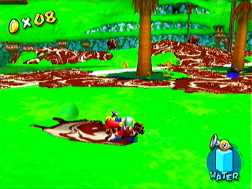
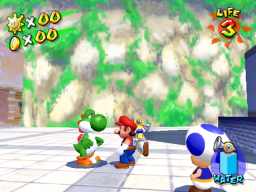
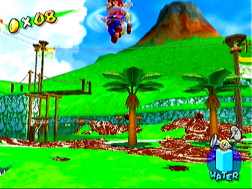
Nintendo’s iconic mascot
returns with his first adventure in more than 5 years in this long-awaited
Gamecube sequel. The brilliant Super Mario Sunshine once again proves the genius
of Miyamoto thanks to better controls and new gameplay elements. Aside from the
expected visual upgrades, Mario’s new water cannon and abilities keep this
from being a rehash of Mario 64. Other new elements have been added such as
dangling and rubber cord jumping. The wait has been long, but Mario Sunshine’s
quality more than makes up for it.
As his latest adventure begins, Mario is vacationing on the sun-baked tropical
island of Delfino with the princess when a mysterious force causes the sunshine
to disappear and graffiti to appear on the once-pristine tropical resort. The
perpetrator bears more than a little resemblance to our plumber and so Mario is
framed and thrown in jail. He has clean up the gooey paint-like substance that’s
been appearing on the island, find the real perpetrator and clear his name.
However, he has some allies, including a new robotic water-spouting device known
as FLUDD. This is strapped to his back. Mario can use this device to spray and
wash away the graffiti that wrecks the island. Cleaning paint is important
because the surface is slippery, and can make certain areas impassable. FLUDD
can also spray and disable enemies. Finally, Mario can also use the device to
levitate in the air for a short time. It’s a limited capacity device so you’ll
need to find water supplies, such as fountains and oceans to refill the tank.
Several enemies also spill out water tablets which can add to your supply. This
adds a whole new dimension of fun and challenge to the game and makes the entire
game feel refreshingly different.
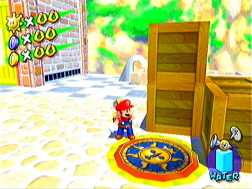 Aside
from the FLUDD system, the game should feel very familiar. Mario still spends a
lot of time running and jumping. Structurally, Super Mario Sunshine seems to
follow in the path of Mario’s last adventure, though the plot is more
elaborate making for a more cohesive game this time. Another new element in
Mario Sunshine are the rubber cords scattered throughout the levels. You can
walk across these like tightropes or they can be jumped on to spring higher and
reach otherwise unreachable heights. This is really cool and is another welcome
addition to the gameplay. There seems to be more in the way of exploration with
more than 100 different sub-levels in the game to keep you constantly
challenged, though you don’t need to visit every one to complete the game.
There are standard levels, boss levels and bonus levels which lends Mario
Sunshine plenty of variety and adds to the replay value and fun. Mario Sunshine
is a semi-linear experience meaning that levels can be played in any order you
want, though you need to get through the long first section before more
branching sections open up. This balance is classic Miyamoto design, motivating
the player to keep exploring throughout each level to find the many hidden items
and secrets. Despite those new elements, many aspects of Sunshine should be
familiar. Mario’s many tasks include the classic system of collecting various
coins and items, with blue and red coins, plus the standard yellow ones. Fans of
the series will find that many familiar friends and foes make return appearances
including Yoshi, Princess and the Koopas. There are also many new characters
including his new archrival.
Aside
from the FLUDD system, the game should feel very familiar. Mario still spends a
lot of time running and jumping. Structurally, Super Mario Sunshine seems to
follow in the path of Mario’s last adventure, though the plot is more
elaborate making for a more cohesive game this time. Another new element in
Mario Sunshine are the rubber cords scattered throughout the levels. You can
walk across these like tightropes or they can be jumped on to spring higher and
reach otherwise unreachable heights. This is really cool and is another welcome
addition to the gameplay. There seems to be more in the way of exploration with
more than 100 different sub-levels in the game to keep you constantly
challenged, though you don’t need to visit every one to complete the game.
There are standard levels, boss levels and bonus levels which lends Mario
Sunshine plenty of variety and adds to the replay value and fun. Mario Sunshine
is a semi-linear experience meaning that levels can be played in any order you
want, though you need to get through the long first section before more
branching sections open up. This balance is classic Miyamoto design, motivating
the player to keep exploring throughout each level to find the many hidden items
and secrets. Despite those new elements, many aspects of Sunshine should be
familiar. Mario’s many tasks include the classic system of collecting various
coins and items, with blue and red coins, plus the standard yellow ones. Fans of
the series will find that many familiar friends and foes make return appearances
including Yoshi, Princess and the Koopas. There are also many new characters
including his new archrival.
Delfino is populated with many blue-hued inhabitants
that Mario can interact with. There are loads of smaller tasks to complete and
you earn coins when you complete these. Helping you travel faster are the
underground mazes. These are reached by butt-bouncing on the manhole covers and
falling into the sewers. In addition to making you go to different sections
faster, you’ll also find hidden items down below. One of the cooler parts of
Sunshine are its enemies which emerge from the paint, most of these are small
creatures which are harmless. There are larger more dangerous foes that resemble
Venus Flytraps, and make for some impressive sub-bosses. Mario needs to beat
these using FLUDD, which but can give up additional coins along the way. There
are also main boss confrontations, which are highly elaborate and challenging as
well. Sunshine has an excellent play balance, which alternates between action
and puzzle sequences. Some of the bonus levels are incredibly challenging while
others, specifically the Amusement Park areas are just plain fun.
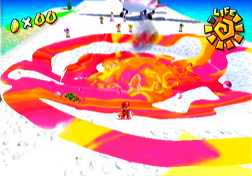 The
Gamecube’s standard controller is perfect for this type of game and makes it a
blast to play. Marios Sunshine refines Mario 64’s controls and feels and
controls with more grace. Its interface feels a lot better overall, though the
analog controller seems a tad sensitive. There are certain areas where the
precision required makes things frustrating, but these control issues aren’t a
major issue after you become accustomed to it. Using both analog sticks to makes
a more intuitive system with far fewer glitches than the first game. Controlling
this on the fly using the right analog stick is much easier, and the viewpoints
themselves rarely interfere with the action. The FLUDD system is well-integrated
and feels like a natural extension of the other controls. Aiming your streams is
a bit annoying but for the most part, this is an intuitive and enjoyable
addition to the gameplay. The water system gives the sophisticated, polished
play a boost that keeps the mechanics fresh.
The
Gamecube’s standard controller is perfect for this type of game and makes it a
blast to play. Marios Sunshine refines Mario 64’s controls and feels and
controls with more grace. Its interface feels a lot better overall, though the
analog controller seems a tad sensitive. There are certain areas where the
precision required makes things frustrating, but these control issues aren’t a
major issue after you become accustomed to it. Using both analog sticks to makes
a more intuitive system with far fewer glitches than the first game. Controlling
this on the fly using the right analog stick is much easier, and the viewpoints
themselves rarely interfere with the action. The FLUDD system is well-integrated
and feels like a natural extension of the other controls. Aiming your streams is
a bit annoying but for the most part, this is an intuitive and enjoyable
addition to the gameplay. The water system gives the sophisticated, polished
play a boost that keeps the mechanics fresh.
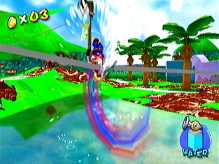 As expected, Super Mario
Sunshine looks amazing and the presentation is exceptional. Easy to understand
icons show you your health and status easily. The attention to detail is
apparent in the richly detailed world, complete flying birds, glistening
sunshine, and realistic looking buildings. Mario Sunshine’s bright,
color-drained environments are huge and evoke the tropical setting perfectly.
Outstanding water effects are present throughout and feature realistic waves and
flow beautifully in the sunshine. The excellent character designs bring the
Nintendo classic into 3D even more vibrantly than before. Mario animates
brilliantly, with a nice arsenal of moves and animations reflecting his winning
personality. There are also some impressive special effects, and one of the
cooler effects occurs when Mario ‘warps’ through the graffiti on the island
to transport to other levels. Mario Sunshine’s bonus levels are typically
weird Miyamoto, with odd-ball colors, strange adversaries and wacky music
heightening the sense of surrealism. The soundtrack fits Sunshine’s
light-hearted feel perfectly while the soundtrack reprises classic Mario themes,
with new tracks in the same spirit.
As expected, Super Mario
Sunshine looks amazing and the presentation is exceptional. Easy to understand
icons show you your health and status easily. The attention to detail is
apparent in the richly detailed world, complete flying birds, glistening
sunshine, and realistic looking buildings. Mario Sunshine’s bright,
color-drained environments are huge and evoke the tropical setting perfectly.
Outstanding water effects are present throughout and feature realistic waves and
flow beautifully in the sunshine. The excellent character designs bring the
Nintendo classic into 3D even more vibrantly than before. Mario animates
brilliantly, with a nice arsenal of moves and animations reflecting his winning
personality. There are also some impressive special effects, and one of the
cooler effects occurs when Mario ‘warps’ through the graffiti on the island
to transport to other levels. Mario Sunshine’s bonus levels are typically
weird Miyamoto, with odd-ball colors, strange adversaries and wacky music
heightening the sense of surrealism. The soundtrack fits Sunshine’s
light-hearted feel perfectly while the soundtrack reprises classic Mario themes,
with new tracks in the same spirit.
Super Mario Sunshine obviously isn’t as revolutionary as Mario 64 but the
evolution of the series is plain to see in direct comparison. The many technical
improvements seems to have allowed more focus on the play itself, with more
emphasis on plot and gameplay twists. This goes a long way in making for a title
that’s fresh yet classic, challenging yet rarely frustrating, and incredibly
fun throughout. It’s nice to see some creativity in the new design because it’s
reassuring that Mario isn’t standing in place. As usual the play balance is
almost flawless, with new elements blending nicely into the classic formula and
feel. There’s going to be a flood of 3D platformers coming out this fall, but
once again Miyamoto has set the bar very high. While Mario Sunshine isn’t
perfect, it seems unlikely anyone else will be able to reach the heights he and
Nintendo routinely reach.

